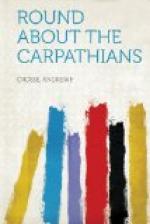The number of excursions to be made in the Hatszeg Valley is endless. On one occasion I took my horse and rode off alone to inspect mines and mining works in the mountains. While looking over the ironworks at Kalan, I was told of the existence of some Roman remains in the neighbourhood, so taking a boy from the works with me to act as guide, I set off, walking, to examine the spot. He led me into the middle of a field, not far off the main road; and here I found the remains of a Roman bath of a very interesting character.
It was singularly constructed. I must observe first that there was a protruding mass of rock rising about fifteen feet above the surrounding ground, and of considerable circumference. In the middle of this there was a circular excavation ten feet in diameter and ten feet deep. At the bottom I discovered a spring of tepid mineral water, which flowed away through a small section cut perpendicularly out of the wall of the great bath; judging from other incisions in the stone, a wooden slide may have been used to bay back the water. On the face of the rock I noticed a Roman inscription, but too much mutilated for me to make anything of it. An attempt had been evidently made to utilise this mineral water, for in the field were some primitive wooden bathing-houses, and not far off there was actually a little inn, but I fear the public had not encouraged the revival of the Roman bath.
In poking about after game or minerals, one frequently comes upon evidence of the former occupation of the country. Speaking of game, the partridges are not preserved, and they are scarce; of course I was too early, but in autumn the woodcock-shooting, I understand, is first-rate. Quails and snipes are also common in the Hatszeg Valley.
Herr von Adam Buda, or, as one should say in Hungarian, Buda Adam (for the Christian name always comes last), has devoted much time to the avifauna of Transylvania. He has a fine collection of stuffed birds at his residence at Rea, near Hatszeg. These are birds which he has himself shot, and he is quite the local authority upon the subject.
I have alluded to the trout-fishing in the district. I went out frequently, and had generally very fair sport indeed. Mr Danford, in his paper in ’The Ibis,’[13] in speaking of fishing, says: “Perhaps the best stream in the country is the Sebes, which joins the Strell near Hatszeg. The trout are not bad, one to two lbs. in weight; and the grayling-fishing is really good—almost any number may be taken in autumn, when weather and water are in good order. The Sil also, near Petroseny, is a fine-looking river, and used to be celebrated for its so-called ‘salmon-trout;’ but these had quite disappeared when we saw it, having been blown up with dynamite, a method of fishing very commonly practised in the country, but now forbidden by law. Indeed fly-fishing is gaining ground, and English tackle in great demand.”
This practice of the wholesale destruction of fish by the use of dynamite has not been stopped a moment too soon; and some time must now elapse in certain waters before they can become properly stocked again.




